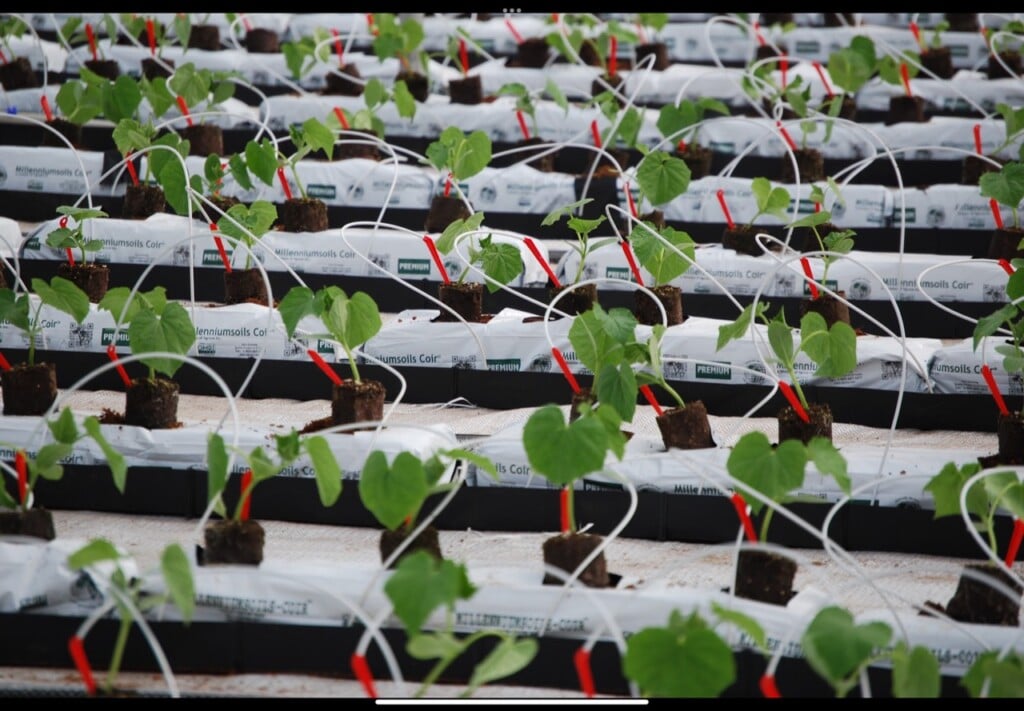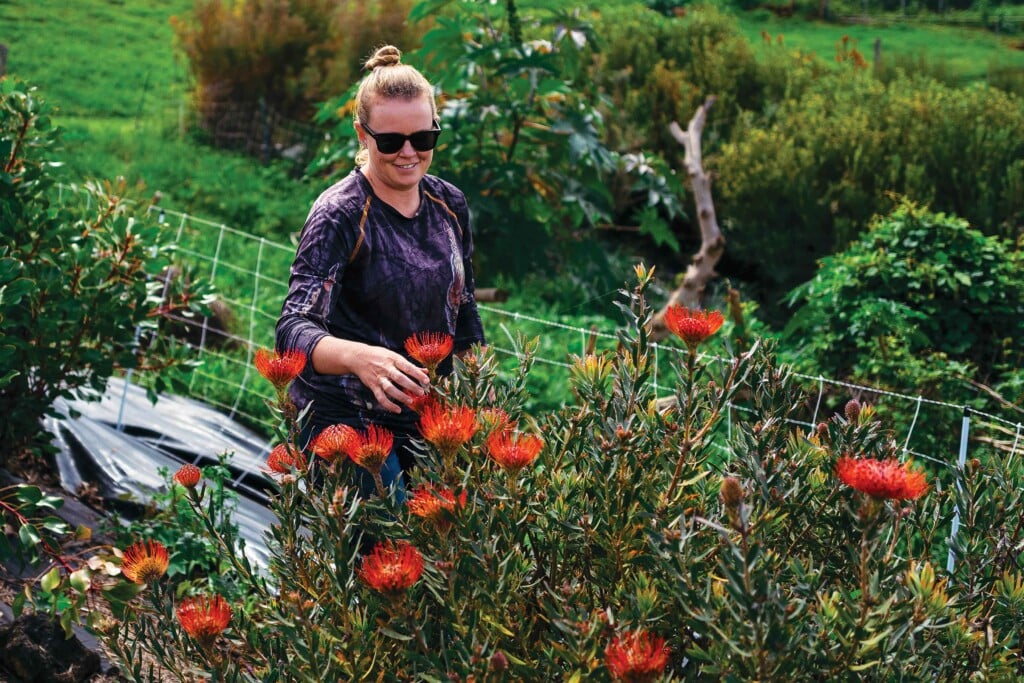How Ag Tech Is Helping Hawai‘i Farmers Grow More Food
Innovations such as data sensors, drones and controlled environments make farming easier, more productive and more profitable.

Jim Wyban remembers back to the 1950s and ’60s, when agriculture generated about half of Hawai‘i’s GDP. Today, he says, ag accounts for about 0.4%.
“We believe that the introduction of technology into agriculture could reverse this bad trend.”
The “we” are Wyban and Jason Ueki, founders and organizers of the Thrive Hawai‘i Agrifood Summit, formerly called the Tropical AgTech Conference.
“The conference is an economic development platform showcasing new climate-smart ag technologies that can increase Hawai‘i ag efficiencies, boost production, increase salaries, create exportable intellectual property and reinvent Hawai‘i ag to be a growth industry,” Wyban says.
This year’s event will be held Sept. 26 and 27 at the Hawai‘i Convention Center in Honolulu.
Replacing an Aging Ag Workforce
Denise Yamaguchi, executive director of the Hawai‘i Agricultural Foundation, says “the average age of a farmer in Hawai‘i and across the nation is 60.” The aging farm workforce is not being replaced by younger farmers.
“Many of us living in Hawai‘i are the fourth or fifth generation of immigrants who came to Hawai‘i and worked on plantations,” she says. But most of our parents, grandparents and great-grandparents, she says, didn’t want their children to become farmers, which has created an ag labor shortage.
Wyban points out another issue: “Farmers aren’t making any money. And when they’re not making any money, they stop farming.” Nor do their children want that often hardscrabble life.
Ag tech may eventually make farming more appealing by alleviating some of the arduous manual labor and making farming more cost-efficient.
“I think one of the emerging technologies that’s really interesting is robots that can pick fruit and vegetables. It’s eventually going to replace some of the more difficult work that is mostly done by immigrant labor,” says Ueki.
Robotic technology is still expensive, but it will eventually be cheaper than human labor, Wyban says.
“Maybe we aren’t going to create more jobs, but the farms will make more money, and it’ll be a more interesting space for young people entering agriculture because in addition to knowing about plant biology and agronomic systems, they’re also going to have to understand how technology works.”
The Hawai‘i Agricultural Foundation’s education programs teach K-12 students about farming operations and careers, with much of the curriculum focused on ag tech and how to use it, Yamaguchi says.
“Kids are really interested in technology. Since the job is not necessarily in the field under the hot sun anymore, it may spark an interest in a different type of job in ag tech,” she says.
Minimizing Problems With Ag Tech
Agriculture is a complicated business. “More so than other industries,” says Yamaguchi, because farmers must consider soil health, pest control, food safety regulations, land leases, water supply and infrastructure.
Weather adds unpredictability and climate change makes severe weather more frequent. One bad storm can ruin an entire harvest and kill livestock.
Some farms are switching to controlled environment agriculture systems, or CEA, to mitigate unfavorable weather and other issues, Yamaguchi says. “You’re able to eliminate the pests that come in, birds that steal your crops, and you’re also able to ensure food safety.”
CEA systems – think greenhouses and other structures – also enable farmers to manipulate the internal climate of these structures so they’re always optimal. “With CEA you can carefully control the environment your plants or animals are in. That way, it’s not vacillating between the extremes of a very high rain event, and then a burning hot sun,” says Ueki. “That’s the pattern it seems we’re moving into with climate change – a fluctuation from super rainy weather to hot, sunny weather every couple of weeks.”
One form of CEA is vertical farming, which involves growing food in vertically stacked rows or on tall towers so there are many more plants on the same footprint.
John Seward, Eric Batha and Lenny Feder of Hawai‘i Farming LLC are cucumber farmers in Waimea on Hawai‘i Island. Their farm uses many kinds of ag tech, including greenhouses, hydroponics and data sensors.
“In controlled environment greenhouses, we can grow a lot more pounds per acre because we are less at risk to weather events,” says Batha. “We also use lots of real time data sensors to test our water chemistry, plant hydration and other variables. This allows us to give our plants exactly what they need to be the most healthy and greatest tasting cucumbers.”
Adds Seward: “Every cucumber plant has its own dripper. I’d say from an environmental perspective, we use 90% less water with very targeted hydroponic growing than you would farming in an open field.”
Seward says CEA also means fewer pests, such as those that lead to rat lungworm disease, compared to open fields, which “definitely minimizes the use of herbicides and pesticides.”
CEA systems like vertical farming and hydroponics require upfront investments beyond the reach of most farmers, but they have proven effective at reducing traditional ag problems. And they merely scratch the surface of ag tech’s possibilities.
Reducing Ag Theft
Agriculture theft and vandalism are huge problems in Hawai‘i – and it’s not just people stealing a few papayas at a time.
“Ag theft is industrial in the sense that they take everything,” says Sharon Hurd, chair of the Hawai‘i Department of Agriculture. “They take every avocado on your tree, every sweet potato in the ground, every flower off your tree. That’s ag theft – when you are left with nothing.” Criminals are also stealing livestock, equipment, chemicals and fertilizer and other farm property.
A farmer’s worst nightmare can be waking up to find all of their crops stolen just before the harvest. According to the latest survey on Hawai‘i agricultural theft and vandalism, conducted in 2019, the total number of theft incidents that year was estimated at 3,616. That same survey estimated there were a total of 14,262 trespassing incidents, posing a huge threat to food safety.
“The total value of theft and vandalism losses, as well as security costs, from Hawai‘i farms is estimated at $14.4 million, or 10% of the 2018 Hawai‘i net farm income of $142 million,” the report said.
For comparison, American retailers lost $94.5 billion from theft in 2021, but that was only 1.4% of total sales.
“If we don’t solve ag theft. I think we’ll lose a lot of farmers because they aren’t reaping the benefits of their hard work,” says Hurd. “One farmer in Mililani spends about $200,000 a year on security measures because if he doesn’t, he’ll lose everything.”
Heavy surveillance such as motion sensing cameras and drones can alert farmers. Extensive fencing, especially electric fencing, is another way to keep out unwanted visitors. And farmers who live on-site also deter thieves, trespassers and vandals.
Hurd points to a newer tactic: Farmers can use “a magic liquid that marks every fruit on the tree.” It can only be detected with a certain kind of light, she says, so when you go to the farmers market or the supermarket you can shine it on produce to see if it might have been stolen.
Killing Two Birds With One Stone
Farmers can also increase their revenue by transforming crops into value added products. Hurd provides one example: “If you have a raw potato and then turn it into a potato chip, you’ve added value to it. This means you can now sell it for a higher price.”
Mangoes with bruises and other imperfections may be shunned in the produce aisle, but they are perfectly good for making dried mango, mango juice, mango puree or mango powder for flavoring, soap, essential oils, lotions and more – using food processing equipment like dehydrators, juicers, pulverizers and freeze dryers.
When I ask cucumber farmers Seward and Batha if they’d considered selling pickles, they both laugh. “Only about every 30 minutes!” says Batha. “Pickles would be a great business for us, absolutely. But first, we need the people and facilities to do it at that scale, and construction here is painfully slow. But we have plans to do it eventually.”
Adding value to a product can also extend its shelf life. Cucumbers only last a couple of weeks in the fridge but an unopened jar of pickles can stay good for well over a year and much longer than a couple of weeks even after opening.
A long shelf life is crucial for Hawai‘i exports, and that shelf life can be extended by techniques such as Hiperbaric high pressure processing.HPP uses intense pressure to kill microorganisms and because it does not use extra heat, it preserves taste, texture, appearance and nutritional value better than traditional preservation methods.
“HPP is a game changer, but it’s expensive,” Hurd says. “So what we can do is have food processing facilities that multiple farms can share. That will provide the equipment that will extend the shelf life to maybe two years.”
Food processing facilities are huge spaces that can contain myriad food processing equipment, including packaging and labeling machinery.
“You have to have the whole supply chain, right? A place to accept it, process it, and then ship it,” Hurd says. There are currently nine food processing plants in Hawai‘i – two on O‘ahu, three on Moloka‘i and four on Hawai‘i Island – and more are being built to meet the high demand.
The challenges faced by Hawai‘i’s agriculture industry are plentiful, but so are the ideas to overcome them. People like Hurd, Yamaguchi, Wyban and Ueki are passionate about coming up with solutions and they say innovation and technology are the keys to unlocking Hawai‘i’s potential to have a thriving agriculture industry.
“If we can create solutions to increase productivity, efficiency and profitability of our companies in Hawai‘i, we can then export that technology to a lot of small farms around the world,” says Ueki. “So if we can grow profitably in Hawai‘i, we can probably grow profitably anywhere in the world.”






